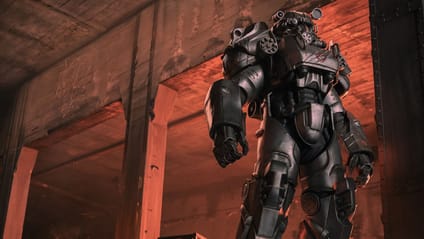
Fallout season 2: what to expect next in the series, based on the games
The juiciest source material the Prime series hasn’t touched on yet


That Fallout TV show’s quite good, isn’t it? Dispelling any remaining outdated ideas about game adaptations being absolute guff, the Amazon Prime series has stockpiled critical acclaim and social media buzz like a doomsday prepper who subsists on plaudits. It’s one of the TV events of the year, and if we’re being honest with ourselves, we’ve all burned through those first eight episodes way too quickly.
Now faced with the eerie post-credits silence and the long wait until season two, we’ve got a bit of time to kill. So obviously we’ve already started writing season two in our minds, using all the grisly component parts of the games that have yet to be referenced by the show.
Advertisement - Page continues belowThe ‘Fat Man’ mini-nuke launcher

Some game designers worry about balancing their arsenal of weaponry so the player has to take a beat and consider the most efficient tool for the task at hand (that task inevitably being to turn enemies into a gooey preserve). Then there are Fallout game designers, who hand you a launcher that fires tactical nuclear ordnance.
One squeeze of the trigger and not only are petty trifles like super mutants wiped away, so are the chances of farming anything on that land for the next few centuries. Would a shotgun have done the job? Absolutely. No counter-argument, no ifs or buts. You should have just used a shotgun.
The ‘Fat Man’ appears in Fallout 3, Fallout: New Vegas, and Fallout 4 in the main series, and also in the mobile spinoff Fallout Shelter. It’s even in the Fallout board game. An appearance on the TV show feels inevitable, but perhaps the writers are just sticklers for authenticity - ammo’s extremely scarce for the Fat Man in all the games it appears in.
Deathclaws

Deathclaws look like the contents of a dinosaur’s nightmare: bipedal, horned, scaly giants who exhibit unbridled ferocity when confronted by – well, absolutely anything. They might look like some hideously irradiated, mutated evolution of a goat, but these things were actually deliberately engineered by we humans - pats on the back all round, everyone. Go us.
In Fallout lore, Deathclaws were developed by the US military to replace human troops in ground conflict. When the Great War broke out and the bombs dropped, while humanity set to work being all but obliterated, these chaps just shrugged and wandered out into the wasteland.
They’ve appeared in every Fallout game since the 1997 original, including spinoffs like Fallout: Tactics and yes, the show’s writers are aware of them thankyouverymuch.
“We wanted to get Deathclaws, but we didn’t want to just throw it away. It’s such a monumental piece,” co-showrunner Graham Wagner told TheWrap. This one’s all but nailed on for a season two appearance, then.
Advertisement - Page continues belowAliens

They’re not a massive presence in any of the Fallout games, but extraterrestrials are always there, lurking in the background, crashing their kitsch flying saucers for players to find and carelessly leaving their advanced weaponry around like discarded bus tickets on Earth’s surface.
The ‘alien blaster’ you find in Fallout 1 is one of the most powerful weapons in the game. Same goes for the weapon’s subsequent appearances throughout the years. Downed space ships and dead aliens are consistent features too, so we just can’t imagine reaching the credits on season two’s final episode without having crossed paths with some good old-fashioned, farmer-terrorising visitors from further afield.
The Master

A quick Fallout timeline: season one of the TV show is set in the year 2296, quite some years after the events of every Fallout game. Back in 2161, the original Fallout game took place, and in that story’s denouement the player comes face to face with a big bad called The Master.
The Master’s plan - the Masterplan, if you will - was to infect all surviving humans with FEV, or ‘forced evolutionary virus’, mutating everyone horrendously but making them theoretically more hardened to the wasteland’s harsh conditions. No less dastardly than we’d expect from a guy who’s basically some viscera with a face, wrapped round a giant computer screen.
Don’t lose sleep over him though, because The Master is no more by the time the TV show’s timeline begins. However, discontinuous narrative was used generously in season one to tell The Ghoul’s story - why not a bit of a flashback to one of the series’ most menacing and enigmatic antagonists?
A whole episode about someone messing about with lightboxes

Remember the halcyon days of 2015, when Fallout 4 came out? The visuals! The new story! What dark, haunting paths might we be guided down by this vast new open world RPG, we wondered.
Then we discovered the new base-building tools and put all that adventuring on hold while we spent 20 hours faffing about with funny light displays.
A core activity of the vault-dweller which, oddly, the first season overlooked entirely. We can only hope the next batch of episodes rectifies this by dedicating a full 60 minutes to Lucy placing and wiring coloured lights for her own amusement.
Season 1 again, this time in slightly higher resolution

One of the show’s executive producers is Bethesda Game Studios director Todd Howard, the man who also oversees The Elder Scrolls franchise. Given that Skyrim has been re-released several times in the course of you reading this article alone, it’s fair to say Howard’s Bethesda team love a remaster.
As Fallout 4’s PS5 upgrade is due in a matter of hours at the time of writing, it would simply be canon for the show to re-release its first season with microscopic visual improvements. We don’t particularly want that, you understand, but that hasn’t stopped the deluge of Skyrim and Fallout editions up to this point.
Advertisement - Page continues below
Trending this week
- Car Review
BMW iX3







